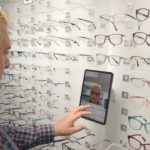
Photo credit: Modern Optical
By Mark Clark, ABOC, MBA
Jan. 5, 2022
I am just old enough to remember as a practice owner a time when I would sit down with my local phone book sales representative to figure out how big of an ad I would place. Back in those days, the main marketing strategy was to either have a giant color picture or give yourself a name that started with an “A” so you could appear first in the list alphabetically. Those were the simple days!
Managing your presence in the digital age is not so simple. For the past 18 months working on a tech project with companies around the world, I have gathered insights on the Metaverse, virtual try-on and telemedicine that I would like to share in an attempt to better understand how these innovations can help an eyecare practice to become more profitable.
What is the “Metaverse?”
“Metaverse” is usually defined as next-generation virtual technology. Here is how Wired recently defined this term: “Broadly speaking, the technologies that make up the metaverse can include virtual reality—characterized by persistent virtual worlds that continue to exist even when you’re not playing—as well as augmented reality that combines aspects of the digital and physical worlds. However, it doesn’t require that those spaces be exclusively accessed via VR or AR. A virtual world, like aspects of Fortnite that can be accessed through PCs, game consoles, and even phones, could be metaversal.”i
Since the tech boom of the nineties, companies have wanted to capitalize on “the next big thing” in technology. And while the Metaverse may be a big announcement, I am not excited about the Metaverse itself. I don’t foresee us giving up being human anytime soon to replace ourselves with avatars in everyday life, or walking around with the latest attempt at something like the failed Google Glass.
I am, however, extremely interested in the software and hardware developments which will result from the Metaverse. The companies which are participating in the Metaverse have software I have used for the last year in my work on virtual try-on. Many of these companies are open-source and in need of funding and development. Companies like Blender, which is an open-source 3D modeling software, will now become more mainstream and well-funded. What does this mean for the average eyecare office? It means that 3D assets of frames will become easier to acquire and adjust over time.
Home computer producers will be pressured to design PCs with proper hardware to be able to view and model 3D assets as the Metaverse becomes more prevalent. This translates to bringing a virtual dispensary more within reach of the average office, as well as a better viewing experience for the end user.
A recent Piplsay study concluded that online shoppers enjoy virtual try-on options as a part of their experience.ii This may soon become an expected part of every e-commerce site, and technology advancements from the Metaverse will help to fuel this.

Virtual Try-On
In the days of old that I mentioned earlier, consumers would often judge a phone book ad by how big the picture was in the business section. Today’s consumer is interested in a meaningful journey online, and today’s large phone book ad equivalent is a dynamic website which offers the user tools that the consumers are seeking.
As I speak with eyecare professionals and web developers around the world each week, I challenge them to examine the successful sites they use regularly and compare them with their current offering. While a section of a website with staff bios and information on dry eye may be nice to include, these items should not be front and center on your website.
Today’s consumer is often on your site because they want to find information about your business or their immediate eyecare needs quicker than with a phone call. They want to immediately find out how to replace the glasses that their son broke for the third time this year at school or, “How do I schedule an eye exam while my daughter is home for college?” They may also want to view the frames in your office without fighting traffic.
I encourage practices to create simple, meaningful customer journeys on their website. Just as Amazon may assume that I need holiday gifts under $20 for an upcoming gift exchange, or yard-working gloves in the spring, eyecare offices need to anticipate the potential needs of their consumer online.
Other Articles to Explore
However, it’s important to remember not to over-complicate your offerings. Your office does not need to offer your full inventory online for consumers to get lost or confused. If you find it hard to keep 2D images on your site, imagine how hard it will be to keep both 2D and 3D assets aligned with a constantly changing frame inventory.
Instead, focus on simple offerings that match what the consumer is most likely to be seeking online. Perhaps they need a quick replacement pair or a second pair for a hobby. Focusing on these needs in your 2D and your 3D virtual try-on will not only save a lot of work for your staff; it will yield better capture rates on your website.
Telemedicine
This is an extremely controversial topic among doctors. The controversy around this is almost as polarizing as asking “who likes coconut?” in their baked goods at the holidays. Many reports from the recent pandemic suggest that patients are increasingly satisfied with telemedicine. Technology advancements of late, and those spinning off from the Metaverse, will only increase the potential quality of the experience.
But just like managing the images on your website, you don’t have to dive in with your whole offering of exam services. The pandemic taught us that not only are some things possible to do virtually, but some of these things may also save office time and space. Insurance companies are rapidly embracing reimbursement models for remote care. While an online full fundus exam may not be in the best interest of each party, perhaps it may make sense to make red-eye follow-ups available remotely.
Conclusion
I encourage eyecare offices not to get overwhelmed, or set too-lofty goals, for their digital presence. Focus on what makes sense for the consumer’s needs and for the flow of the office. The news of emerging technologies and success stories from offices with patient demographics different from your own may not be the best fit for your particular office. Yes, consumer habits are changing dramatically, but you can best align yourself by making simple, yet powerful changes, to your digital presence.
References
i. What is the Metaverse, Exactly, Wired
ii. Virtual try-on tech: How keen are Americans on it?, Piplsay
 Mark Clark ABOC, MBA, is a former practice owner with 20 years in the optical industry. He has an MBA in Healthcare Administration and is Vice-President of Digital Services at Modern Optical International.
Mark Clark ABOC, MBA, is a former practice owner with 20 years in the optical industry. He has an MBA in Healthcare Administration and is Vice-President of Digital Services at Modern Optical International.

























